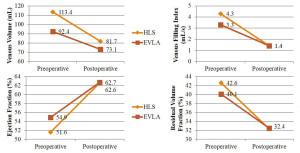Quantifying success in varicose vein surgery is a daunting task. The black and white duplex ultrasound end-point of above knee saphenous occlusion/stripping has no scale, does not take into account perforating veins, disregards the state of the saphenous vein below the knee and ignores extra-saphenous sources of reflux.
Air-plethysmography (APG) is a global assessment of venous drainage, irrespective of the site of disease. Consequently, it is an ideal investigation to quantify treatments on varicose veins, before and after. The group from Seoul (Samsung Medical Centre/Sungkyunkwan University), under the lead of Dong-Ik Kim, use APG in quantifying success in haemodynamic terms.
KYUNG BOK LEE Air-plethysmography is the only practical, non-invasive technique that quantifies haemodynamic changes in varicose vein treatments. We used APG to assess the postoperative haemodynamic changes after two representative varicose vein procedures: high ligation and stripping (HLS) and endo-venous laser ablation (EVLA). The haemodynamic variables of venous volume (VV), venous filling index (VFI), residual volume fraction (RVF) and ejection fraction (EF) were measured pre-operatively and post-operatively.
After varicose vein surgery, all of the haemodynamic parameters improved significantly. The VV, VFI, and RVF decreased and the EF increased. This means that the venous reservoir became smaller, the rate of venous filling (reflux) on dependency decreased, less venous blood remained after calf-muscle pump activity (less pooling) and the efficiency of the calf-muscle pump improved.
In conclusion, our study indicated that overall haemodynamic parameters improved significantly after varicose vein surgery and that APG was able to quantify these changes. We recommend that all varicose vein procedures should undergo a haemodynamic evaluation to quantify success.
Parameters of APG before and after high-ligation with stripping (HLS) and endovenous laser ablation (EVLA).
